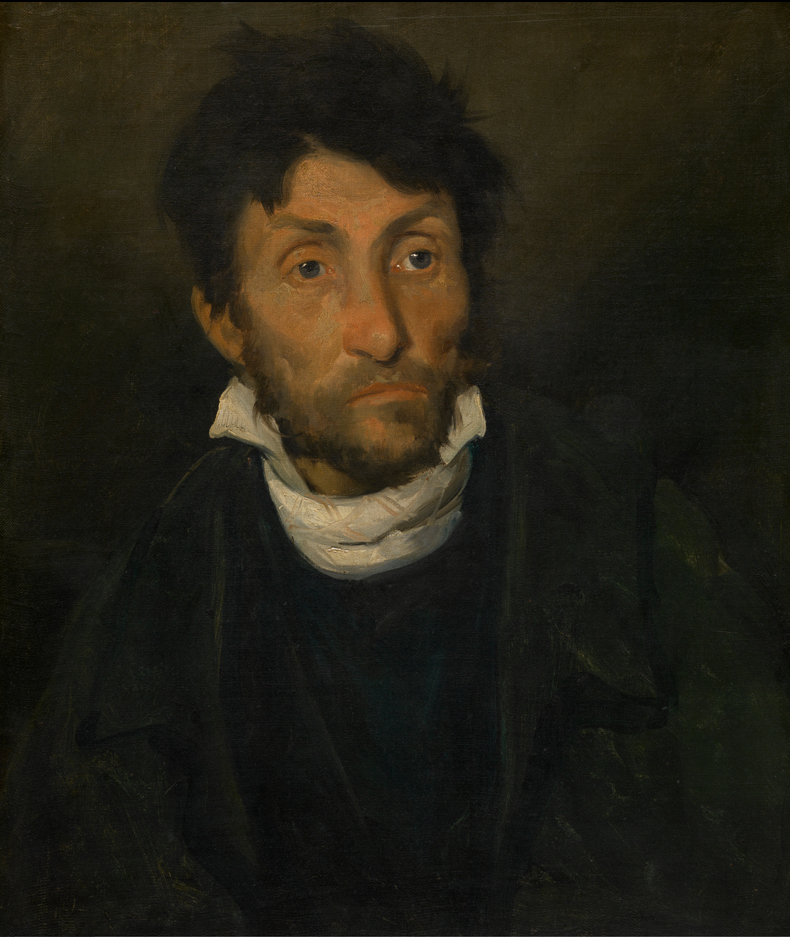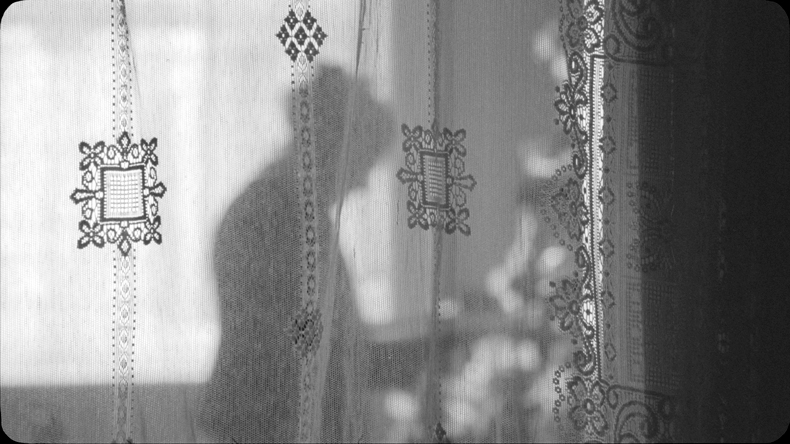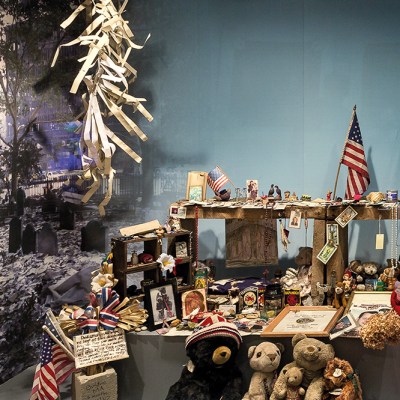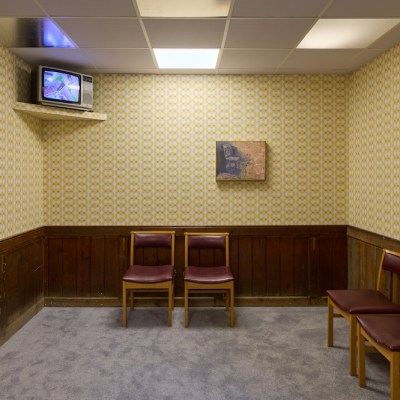In the winter of 1991–92, John Berger found himself wondering why the poster image for the Géricault exhibition then at the Grand Palais was not of one of the artist’s better-known paintings – The Raft of the Medusa or The Wounded Cuirassier, for instance – but a smaller work: Portrait of a Kleptomaniac (c. 1820–24). For Berger, the painting made for an effective banner image because, as he put it in the essay ‘A Man with Tousled Hair’, it ‘pinched us between two fingers’. One finger was Géricault’s evident compassion. The other was the madness of the modern world. ‘There are historical periods when madness appears to be what it is: a rare and abnormal affliction,’ he wrote, as demagoguery and intolerance were finding an increasingly popular avatar in Jean-Marie Le Pen. ‘There are other periods […] when madness appears to be typical.’
Kleptomaniac, then, is a painting for our times. Made as part of a series of ten portraits for the psychiatrist Étienne-Jean Georget, who believed certain mental illnesses to be maladies of the modern age, Kleptomaniac feels as fresh and direct now as it did in the early ’90s or even the 1820s. That’s one reason why it’s the first work you see as you enter ‘Monomania’, an exhibition at the Rijksmuseum curated by the artist Fiona Tan, about mental disorders and how they were diagnosed, treated and, crucially, experienced in the 19th century. ‘I don’t paint any more, but I did when I was a student,’ Tan, who is known mostly for her video installations, tells me over Zoom. ‘Sometimes you’re just in the flow: your hand knows what to do […] That’s the impression I get from this painting: it was done quickly, directly, immediately, without judgement getting in the way. That, for me, is what makes it great: he’s just looking at a human being and painting what he sees.’
Portrait of a Kleptomaniac (c. 1820–24), Museum of Fine Arts, Ghent. Photo: © Lukas VZW/Hugo Maertens

This is the first time the Rijksmuseum has invited an artist to curate a show based on its collection. A number of Tan’s works explore the nature of collections and archives, or are explicitly museological. Inventory (2015) is a series of shots of the collection of the John Soane Museum in London, filmed on six different cameras; her project Shadow Archive (2019) centred around the Mundaneum, a purported archive by the Belgian lawyer Paul Otlet (1868–1944), who sought to collect and catalogue all human knowledge on index cards.
What is it about collections that Tan finds so fascinating? ‘I consider myself an exhibition-maker, which I don’t think you can be without thinking about museums,’ she tells me. ‘A museum isn’t just an idea: it’s a place, with a collection, which always has its own story of push-and-pull, of a tug of war. And collections are never complete […] I think this imperfect, unfinished aspect is really important. It opens up for me these possibilities to find stuff, to step in.’
Japanese mask (c. 1600–1800), artist unknown. Rijksmuseum, Amsterdam

The Rijksmuseum’s collection of a million objects presents a formidable challenge for any sifter. Though the museum’s ‘Bodies’ Stories’ research programme has been looking into ‘physical and mental diversity in the collection’, the curators had not plumbed the collection from a mental health perspective before, let alone a 19th-century one. ‘I’m coming at it from such a different sort of entry point that it’s quite difficult for curators or conservators to immediately latch on and suggest I look at particular things,’ Tan says. ‘It’s an issue I have when I work with archives too: it’s quite hard to say what I’m looking for. I know it when I see it. Part of the work is figuring out how to approach it, figuring out my way through.’
Tan points out that there are very few paintings on display in ‘Monomania’. The 270 objects on display include medical textbooks, mannequins, timepieces and masks. I ask Tan about a piece of linen from 1857 on which letters and pictures have been embroidered in red silk; she tells me it relates to her research into the lives of female patients in the 19th century. ‘All girls had to make these embroideries. What I like about them is that they all had to do exactly the same thing – the alphabet, some crosses, some flowers. You think, “Oh, how boring,” but they’re all completely different. It’s like their personalities were just bursting out, despite these very strict confines of behaviour.’
Christening gown (c. 1800–1900), maker unknown. Rijksmuseum, Amsterdam

It’s handy to be able to ask Tan about particular objects, because there won’t be any explanatory labels in the show. Each room has a short introductory text, and there is a guidebook for visitors, in English and in Dutch, that lists all the works in the exhibition and provides in-depth information for certain objects. Museum labels are ‘a bee in my bonnet,’ Tan says. ‘I know it’s coming from the educational aspect of museums’ [missions], but I find it a shame – I observe too many members of the public coming into an exhibition where they read the text, look at the work, take a photo of it, and leave.’
Tan’s view of herself as an exhibition-maker means that she is ‘always confronted with spaces and architecture and how to deal with that. How do you energise the space? What’s the route, what’s the mise en scène? What’s the dramatic throughline?’ ‘Monomania’ takes a thematic approach. ‘The exhibition starts off scientifically, medically – what was life like for a patient in a mental health institution at that time?’ Tan explains. ‘It’s also from the point of view of psychiatrists – what were they trying to do? […] Emotional expression was something both artists and scientists were interested in. There’s a whole room dedicated to that – the scientific, but also artistic, way of observing things from the outside.’
Character Head (c. 1770–83), Franz Xaver Messerschmidt. Federal Administration of Moveables, Vienna

Making the internal visible is also what Tan is doing here. The exhibits have been pulled out of the museum stores, as if to highlight hidden neuroses and anxieties in the collection. After the room containing Kleptomaniac, visitors enter a gallery that tries to imagine ‘what’s it like to be insane, to have delusions or be hallucinating’. For that, Tan didn’t take long to settle on Goya. ‘He became deaf when he was 46 but lived ’til he was 88, so he was deaf for a very long time. When you look at his prints again, I feel like I can see that he’s looking at the world around him without being able to hear it. And that makes you a very keen observer. It also makes you question human behaviour: why are they doing such weird stuff? Why are they treating each other so badly? That’s the gaze of a sort of outsider. Goya was by no means insane, but I felt it was valid to include those prints there.’
There are also a number of international loans – including Géricault’s Kleptomaniac, which has travelled from the Museum of Fine Arts in Ghent. Of the ten paintings in the series made for Georget, five are considered missing; some years ago, Tan resolved to make an artwork to take their place. That piece is now the final exhibit in the show: a three-screen video installation named Janine’s Room, inspired by a character in W.G. Sebald’s The Rings of Saturn – a lecturer who lives alone, surrounded by a landscape of books and papers. There’s a hint that Janine is more hoarder than collector, though Tan’s film seems to blur the distinction. In Sebald’s novel, Janine is obsessed with Flaubert, particularly the presence of sand in his work; in the film, sand cascades on to the papers from above, suggesting not only the passage of time but also a gradual burial. What are vital research documents now will one day become artefacts – maybe even collectors’ items.
Still from Janine’s Room (2025) by Fiona Tan. Courtesy Fiona Tan and Frith Street Gallery; © Fiona Tan

Tan has mixed feelings when her own work enters a collection. It’s hard not to feel flattered, she says: ‘Somewhere in my contract with the Tate Modern […] it says something like they “undertake to look after the work in perpetuity”. That’s quite a responsibility that they’re taking on.’ But when it comes to meeting collectors, ‘I always feel quite uncomfortable […] I start feeling like a monkey in a cage and have to think, “It’s not me, it’s the work!”’
‘Monomania’ is also interested in feelings of entrapment – of being the studied rather than the studier. In this context the lack of wall labels isn’t just a snook cocked at a certain kind of museumgoer but also a rejection of the urge to categorise. Since categorising is one of the core functions of an institution such as the Rijksmuseum, a productive tension arises between the exhibition and its setting. One of the Rijksmuseum curators told Tan that ‘I make choices she wouldn’t dare make because they’re not academically “responsible”, but they make sense and they’re exciting and interesting to look at. It’ll be interesting to see whether that might push her to start curating in a different way. I thought it would be great if I could somehow shake things up a bit.’
‘Fiona Tan: Monomania’ is at the Rijksmuseum, Amsterdam, from 4 July–14 September.



